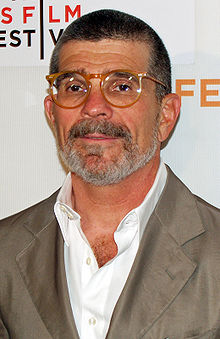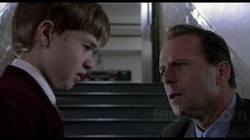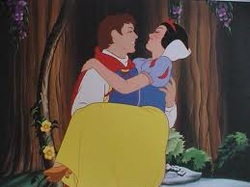
David Mamet Memo to Writers of THE UNIT
| Linda Aronson |
|
 I'm a great fan of David Mamet. Brilliant writer and excellent on the practicalities. In my view his Wag the Dog is probably the best political satire in English. Check out these comments: David Mamet Memo to Writers of THE UNIT
0 Comments
 I’ve just come across someone referring to ‘cheap suspense’ in films, ‘cheap suspense’ defined as when a crucial fact in the story is withheld so as get impact. You and I would probably call it ‘a twist’. Fascinatingly, the example given of a film thus ‘cheap’ was The Sixth Sense, and it was argued that a final twist like this was often the sign of a writer who didn’t know how to end the film. 1) The Sixth Sense was an enormously popular film, so clearly ‘cheap suspense’ (the final twist) is attractive to a lot ofaudiences. We already know this from Agatha Christie novels, which also speciliase in the crucial last minute reveal. No professional writer ignores massive audience approval. 2) The final twist is, I would suggest, usually well-planned. It is certainly not easy, as the term ‘cheap’ suggests. To mislead the audience so that the majority never pick the final twist is very clever indeed. What fascinates me that a value judgement on a narrative structure is being passed off as valid criticism. Suspense cannot be ‘cheap’. Suspense is suspense until it’s proven to have been unmerited. You can criticise a film that sets up great suspense then doesn’t pay it off. Fine. But moral judgements? I don’t think so.  I've had a question about how to write a fairy tale from a writer who was blocking. He'd read my book The 21st Century Screenplay for help but was still stuck and wanted further reading. Okay. I don't think this person needs further reading. From the sound of it, the kind of blocking he's experiencing is usually caused by the writer being too critical too early in the problem solving process. Now, being critical is essential, but you mustn't do it too early or you'll freeze. Being too critical too early is the result of inexperience at having to write to order. So, I'd say to this writer, it sounds to me as if you don't need further theory, you need practice, specifically, you need to practice the creativity under pressure techniques I've given you in the book. These techniques are not easy the first few times you use them because you need to stand back and ponder the problem - when what you long for is an idea now, instantly, fully formed out of the blue! It rarely works like that. When you are working to order, you get ideas methodically, by throwing the right triggers at your imagination. Don't expect flashes of inspiration instantly. Sometimes you'll get them, but normally you will get your brilliant ideas only when you've given yourself useful triggers and done a bit of brainstorming. The method takes time but it does get easier the more you do it. What people find hard is getting the triggers. You get the triggers by defining very precisely for yourself what you are being asked to do. THat's hard, but let's look at it. So, what is 'a fairy tale?' Use my Genre Equation from The 21st Century Screenplay. The genre equation is a little recipe for the ingredients of any genre. It is genre = relevant emotion + specific components of the genre + real plus unusual applied to the fairy tale this is: Fairy Tale = the relevant emotion you want to create in the audience with a fairy tale (DEFINE, THEN INSERT THESE) + the specific components in term of plot and characters of a fairy tale (WHAT DO YOU ALWAY FIND IN A FAIRY TALE IN TERMS OF PLOT AND CHARACTER? INSERT THESE) + real (keep your answers real) + unusual (don't make the mistake of thinking that genre means 'do everything I've seen done before'. You have to put a spin on the formula, so be unusual) The components you always find are:
Still stuck? Okay, fiendish Aronson trick for easier brain storming. I devised this focus trick for schoolkids faced with writing a short story in exam conditions (it's in a little book I wrote for school kids called Writing with Imagination', but the method's just as useful for screenwriters and novelists) The trick Write down points 1-3 above. Circle or highlight each noun (that is, circle or highlight ‘magic’ ‘deserving person’ ‘force of evil’ ‘harm’ ‘magic intervention’ 'saviour figure' ‘common sense' ) Now brainstorm many real but unusual versions of each noun. Choose the best and start to put together the story. Structure of a fairy tale The brainstorming should give you lots of ideas, but we need to look now at structure. Fairy tales are usually linear with one protagonist. There is normally a shocking/surprising/wonderful change as the first act turning point (eg fairy godmother figure, appearance of beanstalk whatever). This will usually be the ‘magic good or bad’. Use your first act turning point to go forward to work out your climax and to go backwards to work out your normality. Make your second act turning point the protagonist's worst moment - where all hope seems lost. Then make your protagonist (or their saviour) fight back for your last act. And it all ends happily ever after (because that's part of the formula too) I hope this helps. To summarise, start practising. Don't worry if it feels hard and counterintuitive at first. |
AuthorLinda is a screenwriter, novelist and playwright. As well as teaching and mentoring writers around the world, she regularly consults on screenplays at the highest level in the US, UK and Australia. Subscribe to Linda Aronson's Craft Skills NewsletterArchives
June 2017
Categories
All
Note: Hi everyone. For RSS feed from this blog, you'll need feedly.com or theoldreader.com. Thanks, Linda
|